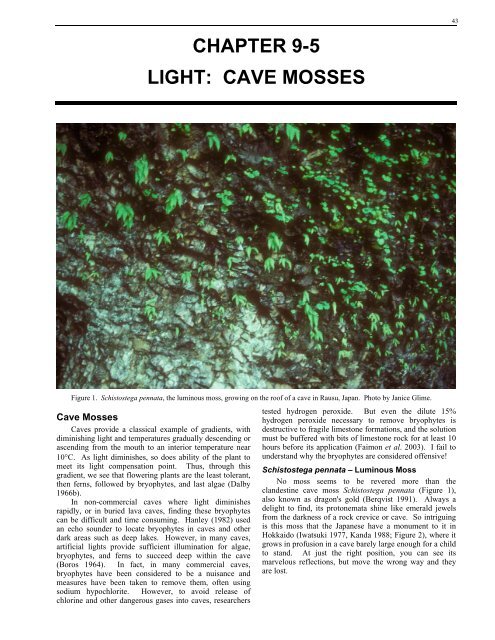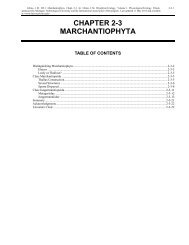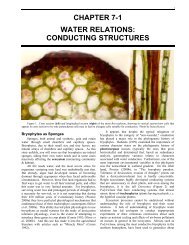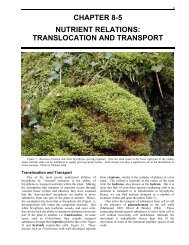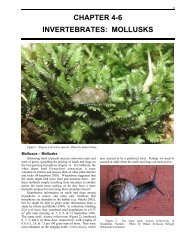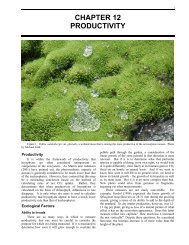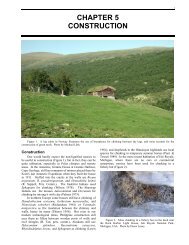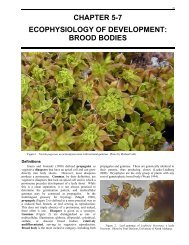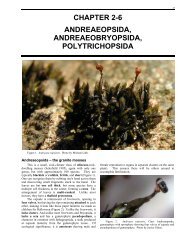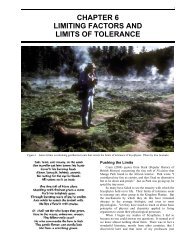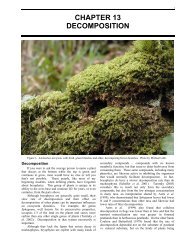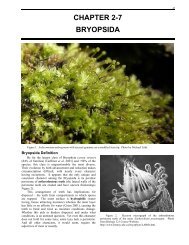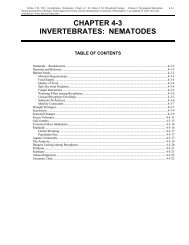CHAPTER 9-5 LIGHT: CAVE MOSSES - Bryophyte Ecology
CHAPTER 9-5 LIGHT: CAVE MOSSES - Bryophyte Ecology
CHAPTER 9-5 LIGHT: CAVE MOSSES - Bryophyte Ecology
You also want an ePaper? Increase the reach of your titles
YUMPU automatically turns print PDFs into web optimized ePapers that Google loves.
<strong>CHAPTER</strong> 9-5<br />
<strong>LIGHT</strong>: <strong>CAVE</strong> <strong>MOSSES</strong><br />
Figure 1. Schistostega pennata, the luminous moss, growing on the roof of a cave in Rausu, Japan. Photo by Janice Glime.<br />
Cave Mosses<br />
Caves provide a classical example of gradients, with<br />
diminishing light and temperatures gradually descending or<br />
ascending from the mouth to an interior temperature near<br />
10°C. As light diminishes, so does ability of the plant to<br />
meet its light compensation point. Thus, through this<br />
gradient, we see that flowering plants are the least tolerant,<br />
then ferns, followed by bryophytes, and last algae (Dalby<br />
1966b).<br />
In non-commercial caves where light diminishes<br />
rapidly, or in buried lava caves, finding these bryophytes<br />
can be difficult and time consuming. Hanley (1982) used<br />
an echo sounder to locate bryophytes in caves and other<br />
dark areas such as deep lakes. However, in many caves,<br />
artificial lights provide sufficient illumination for algae,<br />
bryophytes, and ferns to succeed deep within the cave<br />
(Boros 1964). In fact, in many commercial caves,<br />
bryophytes have been considered to be a nuisance and<br />
measures have been taken to remove them, often using<br />
sodium hypochlorite. However, to avoid release of<br />
chlorine and other dangerous gases into caves, researchers<br />
tested hydrogen peroxide. But even the dilute 15%<br />
hydrogen peroxide necessary to remove bryophytes is<br />
destructive to fragile limestone formations, and the solution<br />
must be buffered with bits of limestone rock for at least 10<br />
hours before its application (Faimon et al. 2003). I fail to<br />
understand why the bryophytes are considered offensive!<br />
Schistostega pennata – Luminous Moss<br />
No moss seems to be revered more than the<br />
clandestine cave moss Schistostega pennata (Figure 1),<br />
also known as dragon's gold (Berqvist 1991). Always a<br />
delight to find, its protonemata shine like emerald jewels<br />
from the darkness of a rock crevice or cave. So intriguing<br />
is this moss that the Japanese have a monument to it in<br />
Hokkaido (Iwatsuki 1977, Kanda 1988; Figure 2), where it<br />
grows in profusion in a cave barely large enough for a child<br />
to stand. At just the right position, you can see its<br />
marvelous reflections, but move the wrong way and they<br />
are lost.<br />
43
44 Chapter 9-5: Light: Cave Mosses<br />
Figure 2. Monument to Schistostega in Hokkaido, Japan.<br />
Photo by Janice Glime.<br />
This unusual jewel-like property (Figure 3) is the result<br />
of the protonema (Gistl 1926). The cells are lens-shaped<br />
(Figure 6) and their upper surface is curved in such a way<br />
as to focus the light on the interior of the cell (Figure 5;<br />
Figure 4). This "normal" form is reached only when they<br />
grow in light that comes at all times from the same oblique<br />
direction. The chloroplasts orient themselves so that they<br />
are always at the most intensely lighted spot on the inner<br />
wall of the cell (Figure 6). If a change in the light direction<br />
occurs, as may happen seasonally, the chloroplasts can<br />
reposition themselves within one to three hours.<br />
Figure 3. Protonemata of Schistostega pennata showing<br />
upright clumps. Photo by Misha Ignatov.<br />
Figure 4. Protonema of Schistostega pennata showing lensshaped<br />
cells. Photo by Misha Ignatov.<br />
Figure 5. The cave moss, Schistostega pennata, reprinted<br />
with permission from Zen Iwatsuki.<br />
Figure 6. Lens-shaped cells of protonema of Schistostega<br />
pennata with chloroplasts arranged on one side of cell to focus<br />
light. Photo by Misha Ignatov.<br />
Like Crum (1973), we find appeal in retelling the<br />
account by Kerner von Marilaun in Pflanzenleben, as<br />
translated by F. W. Oliver in The Natural History of Plants:<br />
"On looking into the interior of the cave, the<br />
background appears quite dark, and an ill-defined<br />
twilight only appears to fall from the center on to the<br />
side walls; but on the level floor of the cave<br />
innumerable golden-green points of light sparkle and<br />
gleam, so that it might be imagined that small<br />
emeralds had been scattered over the ground. If we<br />
reach curiously into the depth of the grotto to snatch a<br />
specimen of the shining objects, and examine the<br />
prize in our hand under a bright light, we can scarcely<br />
believe our eyes, for there is nothing else but dull<br />
lusterless earth and damp, mouldering bits of stone of<br />
yellowish-grey color! Only on looking closer will it<br />
be noticed that the soil and stones are studded and<br />
spun over with dull green dots and delicate threads,<br />
and that, moreover, there appears a delicate filigree of<br />
tiny moss-plants, resembling a small arched feather<br />
stuck in the ground [Figure 8]. This phenomenon,<br />
that an object should only shine in dark rocky clefts,<br />
and immediately lose its brilliance when it is brought<br />
into the bright daylight, is so surprising that one can<br />
easily understand how the legends have arisen of<br />
fantastic gnomes and cave-inhabiting goblins who<br />
allow the covetous sons of earth to gaze on the gold<br />
and precious stones, but prepare a bitter<br />
disappointment for the seeker of the enchanted
treasure; that, when he empties out the treasure which<br />
he hastily raked together in the cave, he sees roll out<br />
of the sacks, not glittering jewels, but only common<br />
earth. . . . On the floor of rocky caves one may<br />
discern by careful examination two kinds of<br />
insignificant-looking plant-structures, one a web of<br />
threads studded with small crumbling bodies, and the<br />
other bluish-green moss-plants resembling tiny<br />
feathers. The threads form the so-called protonema,<br />
and the green moss-plants grow up as a second<br />
generation from this protonema ... the gleams do not<br />
issue from the green moss-plants, but only from their<br />
protonema."<br />
"From the much branched threads ... numerous<br />
twigs rise up vertically, bearing groups of spherical<br />
cells arranged like bunches of grapes. All the cells of<br />
a group lie in one plane, and each of these plants is at<br />
right angles to the rays of light entering through the<br />
aperture of the rocky cleft. Each of the spherical cells<br />
contains chlorophyll-granules, but in small number ...<br />
and they are always collected together on those sides<br />
of the cells which are turned towards the dark<br />
background of the cave.... Taken together, these<br />
chlorophyll-granules form a layer which under low<br />
power of the microscope appears as a round green<br />
spot ... the light which falls on such cells through the<br />
opening of a rocky cleft behaves like the light which<br />
reaches a glass globe at the further end of a dark<br />
room. The parallel incident rays which arrive at the<br />
globe are so refracted that they form a cone of light,<br />
and since the hinder surface of the globe is within this<br />
cone, a bright disc appears on it. If this disc, in which<br />
the refracted rays of light fall, is furnished with a<br />
lining, this also will be comparatively strongly<br />
illuminated by the light concentrated on it and will<br />
stand out from the darker surroundings as a bright,<br />
circular patch.... It is well worthy of notice that the<br />
patch of green chlorophyll-granules on the hinder side<br />
of the spherical cell extends exactly so far as it is<br />
illumined by the refractive rays, while beyond this<br />
region, where there is no illumination, no chlorophyll<br />
granules are to be seen. The refracted rays which fan<br />
on the round green spot are, moreover, only partially<br />
absorbed; in part they are reflected back as from a<br />
concave mirror, and these reflected rays give a<br />
luminous appearance. This phenomenon, therefore,<br />
has the greatest resemblance to the appearance of<br />
light which the eyes of cats and other animals display<br />
in half-dark places, only illumined from one side, and<br />
so does not depend upon a chemical process, an<br />
oxidation, as perhaps does the light from a glowworm<br />
or of the mycelium of fungi which grow on<br />
decaying wood. Since the reflected light-rays take the<br />
same path as the incident rays had taken, it is clear<br />
that the gleams of the Schistostega can only be seen<br />
when the eye is in the line of the incident rays of light.<br />
In consequence of the small extent of the aperture<br />
through which the light penetrates into the rock cleft,<br />
it is not always easy to get a good view.... If we hold<br />
the head close to the opening, we thereby prevent the<br />
entrance of the light, and obviously in that case no<br />
light can be reflected. It is, therefore, better when<br />
looking into the cave to place one's self so that some<br />
Chapter 9-5: Light: Cave Mosses 45<br />
light at any rate may reach its depth. Then the<br />
spectacle has indeed an indescribable charm."<br />
The result of these very reflective chloroplasts in<br />
Schistostega pennata is that the protonema takes on the<br />
appearance of "goblin gold" and can create quite eerie<br />
effects (Figure 7).<br />
Figure 7. Luminous appearance of Schistostega pennata<br />
protonemata. Photo by Janice Glime.<br />
Figure 8. A single plant of Schistostega pennata among its<br />
protonemata, the "small arched feather." Photo by Des Callaghan.<br />
In Japan, there is an opera written about this moss!<br />
The opera, written by Ikuma Dan, is based on a book of the<br />
same title, "Luminous Moss," by Taijun Takeda (Glime &<br />
Iwatsuki 1987). The story relates the tragedy of several<br />
sailors who were stranded by a blizzard on the northern<br />
island of Hokkaido. With no hope of escaping that remote<br />
northern tip of the island before spring to find food and<br />
shelter elsewhere, they hid in a cave. As their rations ran<br />
out and their fellow sailors died of starvation, they did the<br />
only thing they could to survive – they became cannibals.<br />
Finally, the captain alone remains. When he is brought to<br />
trial for his unthinkable acts, he reflects on the halo of<br />
green (the luminous moss) about the heads of each who has<br />
been a cannibal, but he tells the courtroom that the halo is<br />
visible only to those who have not been cannibals. He<br />
alludes to the cannibal in each of us as we struggle to<br />
survive among the millions of the world. Today a cave in<br />
Hokkaido is set aside as a memorial to protect this unusual<br />
moss (Kanda 1971, 1988; Figure 2).<br />
Schistostega pennata is widespread in the North<br />
Temperate Zone. Bowers (1968) and Conard (1938) have<br />
reported it from the Upper Peninsula of Michigan, where I<br />
have seen it growing on the roof of a cave behind a<br />
waterfall. Outside that same cave, I have observed the
46 Chapter 9-5: Light: Cave Mosses<br />
leafy gametophore, which resembles a tiny fern frond<br />
(Figure 9), growing on a small ledge of the rock wall, but<br />
protonemata there, if present, did not exhibit their highly<br />
reflective property. Bowley (1973) found the moss in<br />
several localities in Vermont, Champlin (1969) reported it<br />
from Rhode Island, Christy and Meyer (1991) from<br />
Wisconsin, Case (1975) found it in Alberta, Canada.<br />
Matsuda (1963) reported it in artificial caves in Japan.<br />
Perhaps the most unusual report is that of Koike (1989)<br />
who reported its culture in empty bottles in urban areas of<br />
Japan. Reinoso Franco et al. (1994) considered it to be an<br />
acidophile, at least on the Iberian Peninsula.<br />
Figure 9. Schistostega pennata showing frond-like branches<br />
of leafy gametophyte. Photo with permission from<br />
.<br />
When I went to Germany, I was delighted to find<br />
Schistostega pennata growing at the base of a boulder<br />
where it probably did not get direct sunlight except at<br />
sunset and most likely did not get direct rainfall very often<br />
either. Perhaps one reason for its success in such habitats<br />
is the presence of protonemal gemmae (Edwards 1978).<br />
Cyathodium<br />
In the thallose liverwort genus Cyathodium (Figure<br />
10), some species that grow in caves and similar low-light<br />
environments also emit a yellowish luminescence from<br />
their thalli (Crum 1973). These liverworts are tropical and<br />
subtropical and in China grow in karst caves (Zhang et al.<br />
2004).<br />
Wombat Holes<br />
In Australia, a similar moss, Mittenia plumula (Figure<br />
11) lives on dimly lit, clay-covered rock ledges and at the<br />
entrances to wombat holes, where the moss lives on soil.<br />
Stone (1961, 1986) concluded that Mittenia belongs in the<br />
order Schistostegales with Schistostega. Both have a<br />
pinnate leaf arrangement, protonemata with similar<br />
luminescent properties, similar pale color of the leafy plant,<br />
and similar habitats.<br />
Figure 10. View through pore of Cyathodium cavernarum, a<br />
thallose cave liverwort that emits a yellowish luminescence in<br />
caves. Photo by Noris Salazar Allen.<br />
Figure 11. Mittenia plumula growing in a wombat hole in<br />
Australia. Photos by Janice Glime.<br />
Cave Communities<br />
Growth of other bryophytes in caves far from a natural<br />
light source has been a source of fascination for both<br />
bryologists and non-bryologists all over the world, and<br />
these bryophytes often form zones around electric lights<br />
(Haring 1930). So fascinating are these plants of low light<br />
that their descriptions have appeared in non-botanical<br />
journals. Boros (1964) was able to publish a paper in the<br />
first volume of the International Journal of Speleology<br />
(speleology is the study of caves), reporting on mosses<br />
growing around electric light sources deep within a cave.<br />
Dalby (1966b) later published a similar article on their<br />
growth under reduced light in caves, this time in the first<br />
volume of Studies in Speleology. Numerous communities<br />
have been described from caves around the world: Shiomi
(1973) in Japan; Maheu and Guerin (1935) in France;<br />
Rajczy (1979) in Greece; Ziober (1981), Komáromy et al.<br />
(1985), Rajczy et al. (1986), and Buczkó and Rajczy<br />
(1989) in Hungary; Lo Giudice & Privitera (1984) in Italian<br />
grottos; Stefureac (1985) in Romanian grottos; Weber<br />
(1989) for both animals and flora, including bryophytes, in<br />
two German caves and artificial caverns. Even Science has<br />
accepted articles on mosses in Virginia (USA) caverns,<br />
including the famous Luray Cavern (Lang 1941, 1943), and<br />
Prior again studied Luray Cavern mosses, publishing in<br />
1961 in The Bryologist.<br />
Most cave bryophytes are not specific to these habitats.<br />
Reinoso Franco et al. (1994) have found Schistostega<br />
pennata with Isopterygium elegans (low-light species of<br />
canyons and crevices), Diplophyllum albicans (forest<br />
epiphyte), Calypogeia arguta, C. azurea (also an epiphyte),<br />
Pogonatum nanum, and Fissidens curnowii at a pH of 5.7<br />
in caves.<br />
The widespread Fissidens taxifolius grew in Crystal<br />
Caverns in Virginia, USA, and aroused the curiosity of a<br />
visitor who delivered it to Conard (1932). This moss grew<br />
on the damp ceiling, forming circles about 8" from several<br />
electric light bulbs, having appeared only a few years<br />
earlier. The moss looked normal, but the leaves were<br />
further apart than in typical specimens, not an unusual trait<br />
for a moss of low light.<br />
A variety of species seem to be capable of growing in<br />
caves. Buczkó & Rajczy (1989) reported nineteen<br />
bryophyte taxa from three caves in Hungary. Dalby<br />
(1966a) reported the occurrence of the tufa-former,<br />
Eucladium verticillatum (Figure 12), in a poorly lit cave,<br />
also occurring in caves in Hungary (Buczkó & Rajczy<br />
1989). In Crystal Cave, Wisconsin, Thatcher (1949) found<br />
Barbula unguiculata, Brachythecium populeum,<br />
Brachythecium salebrosum, Bryoerythrophyllum<br />
recurvirostre, Bryum caespiticium, Bryum capillare,<br />
Ceratodon purpureus, Fissidens taxifolius, Leptodictyum<br />
riparium, Marchantia polymorpha, Plagiomnium<br />
cuspidatum, and Warnstorfia fluitans Like Conard,<br />
Thatcher observed the leaves to be more distant than is<br />
typical. Komáromy et al. (1985) likewise found Eucladium<br />
verticillatum, a Brachythecium (B. velutinum), and two<br />
species of Fissidens (F. cristatus, F. pusillus). Within only<br />
one year from its first illumination, Howe Cavern in New<br />
York, USA, already was adorned with Amblystegium<br />
serpens var. juratzkanum, Amphidium mougeotii,<br />
Brachythecium rutabulum, Bryum caespiticium, Bryum<br />
capillare, Leptobryum pyriforme, and Marchantia<br />
polymorpha encircling its new lights (Haring 1930).<br />
Buczkó and Rajczy (1989) found that Amblystegium<br />
serpens (=A. juratzkanum var. juratzkanum; Figure 13) was<br />
the most characteristic moss in several Hungarian caves,<br />
extending furthest from the cave entrance that provided the<br />
only light, surviving at only 232 lux.<br />
It is perhaps not surprising that several tufa formers<br />
such as Eucladium (von der Dunk & von der Dunk 1980),<br />
Barbula, and Didymodon (Figure 14) are found in many of<br />
these caves, since the caves are usually limestone, and tufa<br />
formers must be adapted to relatively dim light to survive<br />
the calcium carbonate covering they must endure.<br />
Chapter 9-5: Light: Cave Mosses 47<br />
Figure 12. Eucladium verticillatum, a tufa-forming moss.<br />
Photo by Michael Lüth.<br />
Figure 13. Amblystegium serpens, a common cave moss in<br />
Hungary. Photo by Michael Lüth.<br />
Figure 14. Tufa-forming Didymodon tophaceus, a former of<br />
didymodontoliths. Note carbonates at base encrusted on older<br />
stems. Photo by Michael Lüth.<br />
With all these reports, it is not unexpected then that<br />
Koponen (1977) reported mosses at a depth of 176 m in a<br />
mine at Vihanti, Finland. The surprising fact is that the<br />
mosses he found are the very light-tolerant Ceratodon<br />
purpureus and Pohlia nutans (Figure 15). But then, these<br />
two mosses seem to do well in extremes, as long as it is not<br />
too hot.
48 Chapter 9-5: Light: Cave Mosses<br />
Figure 15. Pohlia nutans, a widespread moss that frequents<br />
caves and mines. Photo by Michael Lüth.<br />
Jedrzejko and Ziober (1992) illustrated the effects of<br />
light on the species composition of moss communities and<br />
the ability of mosses to survive at low light intensities with<br />
their study of bryophytes in seven Polish caves. More than<br />
50% of the bryophyte flora occurred where they had full<br />
access to daylight. As the investigators went deeper into<br />
the caves, the number of species decreased, but with 1.3%<br />
of the species occurring only in the darkest zone.<br />
Rockhouses<br />
Rockhouses are really just small caves created by deep<br />
recesses in bedrock cliffs. But despite their smaller size,<br />
they can create conditions much different from those of<br />
their surroundings outside the cavity. They tend to be<br />
buffered from extremes in both temperature and moisture,<br />
with cold blasts emanating in the summer and protection<br />
from severely cold winds in the winter. Nevertheless,<br />
despite their moderate climate, their low light levels greatly<br />
restrict the potential flora. It is therefore interesting that the<br />
greatest affinities of these floras are with the tropics (Farrar<br />
1998). While the species in the rockhouses tend to be<br />
endemic to the eastern United States, the conditions created<br />
for them mimic the low light intensities of the dense<br />
rainforests. It is possible that the climatic moderation of<br />
the rockhouses might have permitted adapted plant groups<br />
to persist here since the time when a tropical/subtropical<br />
climate existed in the eastern US during the Pre-<br />
Pleistocene. It is in these secluded habitats that a number<br />
of endemic ferns reside, but the most numerous plants are<br />
the bryophytes. Farrar considered both groups to be<br />
preadapted to this habitat by their vegetative reproduction<br />
and their ability to have net photosynthetic gain in very low<br />
light.<br />
Responses to Low Light in Caves<br />
If you have ever picked up a board from your lawn,<br />
you know how thin and long the grass stems can be. This<br />
elongation response by plants in low light is termed<br />
etiolation. Dunham and Lowe (1927) described etiolation<br />
of bryophytes in caves and among boulders in New<br />
England, USA. But at least some light should be present,<br />
right? Nevertheless, Fries (1945) succeeded in growing<br />
the mosses Funaria hygrometrica and Leptobryum<br />
pyriforme (Figure 16) from protonemata on inorganic<br />
media in total darkness. Thus, it would appear that some<br />
growth can occur, using the plant's reserves, even in the<br />
absence of light.<br />
Rajczy (1978-1979) chose to experiment with growing<br />
mosses in total darkness of a cave. He used two common<br />
Hungarian species, Atrichum undulatum (Figure 17) and<br />
Plagiomnium ellipticum (Figure 18), which he planted in<br />
flowerpots along with their original soil. These were<br />
placed in a cave where the climate is very constant, having<br />
a temperature of 9.5 ±1ºC and 95-100% relative humidity.<br />
Plagiomnium ellipticum rapidly became brown and within<br />
three months had produced long, fine, vertical, leafless<br />
stems of 4-6 cm length. Atrichum undulatum, on the other<br />
hand, remained green for two years. Its chloroplasts<br />
increased from a mean of 8.8 to 10.3 per cell from May to<br />
October. In the cave both species had a much higher ratio<br />
of dark CO2 fixation that did the control samples from<br />
normal light (Table 1). One interesting event in Rajczy's<br />
experiment was that isopods (Mesoniscus graniger)<br />
consumed all the dead material of the plants. The mosses<br />
soon grew pale, then partly brown.<br />
Figure 16. Leptobryum pyriforme, an invader of bare soil.<br />
Photo by Michael Lüth.<br />
Table 1. Incorporation of CO2 into moss biomass in caves<br />
compared to controls. From Rajczy (1978-1979).<br />
14 CO2 Incorporation<br />
Net Activity (cmp/leaf)<br />
total<br />
fix<br />
dark<br />
fix<br />
light<br />
fix<br />
Contrib dk<br />
fix to total<br />
fix<br />
Atrichum undulatum<br />
control 898 85 813 9%<br />
cave sample 174 81 93 47%<br />
Plagiomnium ellipticum<br />
control 3790 340 3450 9%<br />
cave sample 550 220 330 40%<br />
When Atrichum undulatum cells were examined with<br />
the electron microscope after four months of experiment<br />
(September), the chloroplasts differed considerably from<br />
those of the control plants. The size of the grana had<br />
increased but their number decreased and they were<br />
arranged mostly at the periphery of the chloroplast. There<br />
were no starch grains. Then, in March, there was a most<br />
unexpected change. The chloroplasts contained starch once<br />
more and the grains appeared to be identical to those of the
control plants. Thylakoids (Figure 19) were even thinner<br />
than in September, and only 1-2 stroma thylakoids were<br />
present. From 3 to 10 broad, low grana were present.<br />
Figure 17. Atrichum undulatum leaves. Photo by Janice<br />
Glime.<br />
Figure 18. Plagiomnium ellipticum. Photo by Michael Lüth.<br />
Figure 19. Chloroplast with cutaway view to show inner and<br />
outer membrane, stacks of thylakoids that form grana, and<br />
connecting stroma. Drawing by Janice Glime<br />
Surprisingly, Plagiomnium ellipticum also had starch<br />
grains in March. However, these were not like those of<br />
their control plants. Some were far larger, and most<br />
chloroplasts lacked them. Most of the chloroplast<br />
envelopes were torn up.<br />
In April, samples taken from the cave to the lab had<br />
measurable photosynthesis, although they had no exposure<br />
to light prior to the time of measurement. For Atrichum<br />
undulatum, photosynthesis reached 15-20% of that in the<br />
controls. Both species retained some photosynthetic<br />
Chapter 9-5: Light: Cave Mosses 49<br />
activity for the two years of the experiment, but that of<br />
Atrichum undulatum was greater.<br />
Rajczy (1978-1979) interpreted these results to mean<br />
that the mosses were subsisting on heterotrophic energy<br />
sources. He could find no other explanation for the sudden<br />
appearance of starch after 10 months in the cave.<br />
Furthermore, he cited the dark-culturing experiments of<br />
Servettaz (1913), Pringsheim and Pringsheim (1935), and<br />
Fries (1945) to support his position. Could the mosses be<br />
using electromagnetic rays? symbiosis? chemosynthesis?<br />
Cave algae are known to subsist using these unusual<br />
methods of obtaining energy (Kol 1966; Hadju 1971).<br />
And why did both species have starch grains in March<br />
when the grains had disappeared earlier? Did some<br />
endogenous rhythm, lacking stimulus by photoperiod or<br />
temperature, trigger a change in metabolic activity?<br />
Summary<br />
Protonemata of some mosses, such as Schistostega<br />
pennata, are able to position their chloroplasts to<br />
receive maximum available light and the lens-shaped<br />
cells help to focus the light. Their high reflectance<br />
provides a luminescence in caves. Similar reflective<br />
abilities are present in Mittenia plumula that lives in<br />
wombat holes. Cyathodium species that live in caves<br />
have a similar reflective ability in their thalli.<br />
Some bryophytes are able to live in the dim light<br />
surrounding light bulbs in visitor caves, exceeded in<br />
their low-light survival only by the algae. Many of the<br />
cave bryophytes are also typical of other habitats of<br />
greater light intensity, including high-light tolerators<br />
like Ceratodon purpureus and Pohlia nutans. Some are<br />
the tufa formers that often are so encrusted with<br />
limestone that only their tips are able to get sufficient<br />
light for photosynthesis. Amblystegium serpens seems<br />
able to live in the lowest light at only 232 lux.<br />
One response to bryophytes in deep caves is<br />
etiolation, which spaces leaves further apart, thus<br />
exposing more surface area to the little light available.<br />
In some species, the number of chloroplasts and size of<br />
grana can increase and growth can occur even in the<br />
dark. Long, thin "exploratory" branches may form. In<br />
Atrichum undulatum the starch disappeared in winter<br />
but reappeared in spring, in the dark! When placed in<br />
the light, photosynthesis began without delay.<br />
Acknowledgments<br />
Literature Cited<br />
Berqvist, K. 1991. Dragon's gold (Schistostega pennata). Sver.<br />
Nat. 4: 42-43.<br />
Boros, A. 1964. Uber die Moose, die unter dem Einfluss der<br />
elektrischen Beleuchtung in des innere der hohlen in Ungarn<br />
und in der Tschechoslowakei Eindringen. Internat. J.<br />
Speleol. 1: 45-46.<br />
Bowers, M. C. 1968. New localities for mosses rarely found in<br />
Michigan's Upper Peninsula. Mich. Bot. 7: 93-94.<br />
Bowley, D. R. 1973. The environment of Schistostega pennata<br />
(Hedw.) Hook. and Tayl.: New Vermont stations. Rhodora<br />
75: 149-153.<br />
Buczkó, K. and Rajczy, M. 1989. Contributions to the flora of<br />
Hungarian caves II. Flora of three caves near Beremend,<br />
Hungary. Stud. Bot. Hung. 21: 13-25.
50 Chapter 9-5: Light: Cave Mosses<br />
Case, J. W. 1975. New data on the distribution of the moss<br />
Schistostega pennata in Alberta. Can. Field-Nat. 89: 456-<br />
457.<br />
Champlin, R. L. 1969. A Rhode Island station for luminous<br />
moss. Rhodora 71: 305.<br />
Christy, J. A. and Meyer, T. A. 1991. <strong>Bryophyte</strong>s of algific talus<br />
slopes in Wisconsin's driftless area. Rhodora 93: 242-247.<br />
Conard, H. S. 1932. Cave mosses. Bryologist 35: 13.<br />
Conard, H. S. 1938. The foray in Upper Michigan, 1937.<br />
Bryologist 41: 18-22.<br />
Crum, H. 1973. Mosses of the Great Lakes Forest. Contrib.<br />
Univ. Mich. Herb. 10: 1-404.<br />
Dalby, D. H. 1966a. The growth of Eucladium verticillatum in a<br />
poorly illuminated cave. Rev. Bryol. Lichénol. 34: 929-930.<br />
Dalby, D. H. 1966b. The growth of plants under reduced light.<br />
Stud. Speleol. 1: 193-203.<br />
Dunham, E. M. and Lowe, R. L. 1927. Mosses of unusual<br />
growth or unusual habitat. Bryologist 30: 62-65.<br />
Dunk, K. von der and Dunk, K. von der. 1980. Algen und<br />
Moose bauen einen Aquadukt aus Tuff. Mikrokosmos 69:<br />
50-55.<br />
Edwards, S. R. 1978. Protonemal gemmae in Schistostega<br />
pennata (Hedw.) Web. & Mohr. J. Bryol. 10: 69-72.<br />
Faimon, J., Stelcl, J., Kubesova, S., and Zimak, J. 2003.<br />
Environmentally acceptable effect of hydrogen peroxide on<br />
cave 'lamp-flora', calcite speleothems and limestones.<br />
Environ. Pollut. 122: 417-422.<br />
Farrar, D. R. 1998. The tropical flora of rockhouse cliff<br />
formations in the eastern United States. J. Torrey Bot. Soc.<br />
125(2): 91-108.<br />
Fries, N. 1945. Some experiments with mosses cultured in the<br />
dark. Botanisches Not. 417-424.<br />
Gistl, R. 1926. Relation of light to the protonema of<br />
Schistostega. (Beziehung zwischen Licht und Schistostega-<br />
Vorkeim). Ber. Deutsch. Bot. Gesell. 44: 483-492.<br />
Glime, J. M. and Iwatsuki, Z. 1987. <strong>Bryophyte</strong>s in opera.<br />
Bryol. Times 41: 7.<br />
Hadju, L. 1979. Die heutige Lage der Algenforschung in den<br />
Höhlen und deren Probleme in Ungarn. Karszt és<br />
Barlangkutatás 6: 103-116.<br />
Hanley, S. 1982. A technique for surveying aquatic plant<br />
populations using an echo-sounder. Proc., EWRS 6th Symp.<br />
Aquatic Weeds. Novi Sad, Yugoslavia, pp. 171-176.<br />
Haring, I. M. 1930. Plant growth under electric light. Bryologist<br />
33: 89-91.<br />
Iwatsuki, Z. 1977. Schistostega pennata and moss balls –<br />
mosses designated as natural monuments in Japan.<br />
Shizenkagaku Hakubutsukan 44: 64-67.<br />
Jedrzejko, K. and Ziober, A. 1992. The bryophytes of chosen<br />
caves on the Krackòw-Wieluñ Upland and its relation to<br />
microclimate conditions and ecological differentiation of<br />
habitats. Ziemia Czestochowska 18: 107-151.<br />
Kanda, H. 1971. Schistostega pennata Hedw. in Hokkaido: Its<br />
ecology and germination. Hikobia 6: 60-75.<br />
Kanda, H. 1988. The present situation of the colony of<br />
Schistostega pennata Hedw. in the Makkausa Cave, Rausa,<br />
Hokkaido. Proc. Bryol. Soc. Japan 52: 165-166.<br />
Koike, Y. 1989. Culture of Schistostega pennata in empty<br />
bottles in urban areas. Proc. Bryol. Soc. Japan 5: 27-28.<br />
Kol, E. 1966. The effect of algae on germination and growth of<br />
rice I. Adv. Front. Plant Sci. 15: 51-69.<br />
Komáromy, Z. P., Padisak, J., and Rajczy, M. 1985. Flora in the<br />
lamp-lit areas of the cave "Anna-Barlang" near Lillafuered<br />
(Hungary). Ann. Hist. Nat. Mus. Natl. Hung. 77: 103-112.<br />
Koponen, T. 1977. Kulosammal (Ceratodon purpureus) ja<br />
varstasammal (Pohlia nutans) 176 m syvyydessa Vihannin<br />
Kaivoksessa. [Ceratodon purpureus and Pohlia nutans<br />
found at a depth of 176 m in the mine at Vihanti, Finland.].<br />
Luonnon Tutkija 81: 59.<br />
Lang, W. B. 1941. Mosses in the Virginia caverns. Science 94:<br />
414.<br />
Lang, W. B. 1943. The mosses of Luray Cavern, Virginia.<br />
Science 98: 173, 174.<br />
Lo Giudice, R. and Privitera, M. 1984. Sulla brioflora di alcune<br />
grotte etnee (Grotta Forcato, Grotta delle Palombo, Grotta<br />
dei Ladri). Arch. Bot. Biogeogr. Ital. 59(3-4): 137-157.<br />
Maheu, J. and Guerin, H. P. 1935. Influence de la lumiere<br />
electrique sur la flore cavernicole. Bull. Soc. Bot. France<br />
82: 477-494.<br />
Matsuda, Y. 1963. Schistostega pennata Hook. et Tayl. occurs in<br />
artificial caves. Misc. Bryol. Lichenol. 3(3): 41.<br />
Pringsheim, E. G. and Pringsheim, O. 1935. Physiologische<br />
Studien am Mooses. 3. Die Züchtung von<br />
Laubmoosprotonemen im Dunkeln. Jahrb. Wiss. Bot. 82:<br />
311-332.<br />
Prior, P. V. 1961. Studies on the mosses of Luray Cavern.<br />
Bryologist 64: 215-222.<br />
Rajczy, M. 1978-1979. Effect of the cave environment on some<br />
mosses. Ann. Univ. Sci. Budapest. Rolando Eötvös Nom.<br />
Sec. Biol. 20-21: 125-136.<br />
Rajczy, M. 1979. Contributions to the bryoflora of Greece. I.<br />
The bryophytes of the Cave Perama near Joannina. Stud.<br />
Bot. Hung. 13: 3-5.<br />
Rajczy, M., Buczkó, K., and Komáromy, Z. 1986. Contributions<br />
to the flora of the Hungarian caves. I. Flora of the entrances<br />
of the caves Loek-voelgyi-barlang and Szeleta-barlang.<br />
Stud. Bot. Hung. 19: 79-88.<br />
Reinoso Franco, J., Rodriguez Oubiña, J., and Viera Benitez, M.<br />
C. 1994. Precisions on the ecology and chorology of<br />
Schistostega pennata (Hedw.) Webb & Mohr. in the Iberian<br />
Peninsula. Lazaroa 14: 13-19.<br />
Servettaz, C. 1913. Recherches experimentelles sur le<br />
développement et la nutrition des mousses en milieux<br />
stérilisées. Ann. Sci. Nat., Bot. Sér. IX. 17: 111-224.<br />
Shiomi, T. 1973. <strong>Bryophyte</strong>s growing around the illumination in<br />
the Akiyoshi-do cave, Yamaguchi Prefecture. Proc. Bryol.<br />
Soc. Japan 4: 45.<br />
Stefureac, T. I. 1985. Recherches bryospeliologiques sur<br />
certaines grottes de Roumanie. Rev. Roumaine Biol., Ser.<br />
Biol. Vég. 30: 109-116.<br />
Stone, I. G. 1961. The highly refractive protonema of Mittenia<br />
plumula (Mitt.) Lindb. (Mitteniaceae). Proc. Roy. Soc.<br />
Victoria 74: 119-124.<br />
Stone, I. G. 1986. The relationship between Mittenia plumula<br />
(Mitt.) Lindb. and Schistostega pennata (Hedw.) Web. &<br />
Mohr. J. Bryol. 14: 301-314.<br />
Thatcher, E. P. 1949. <strong>Bryophyte</strong>s of an artificially illuminated<br />
cave. Bryologist 52: 212-214.<br />
Weber, D. 1989. Die Höhlenfauna und -flora des<br />
Hölenkatastergebietes Rheinland-Pfalz/Saarland, 2. Abh.<br />
Karst-Höhlenkunde 23: 1-250.<br />
Zhang, C., Li, X., and Chao, C. 2004. New records of luminous<br />
liverworts from the Karst Caves of Guangxi Province,<br />
Prchina: Cyathodium cavernarum Kunze sent C.
smaragdium Schiffin ex Keissler (Cyathodiaceae,<br />
Hepaticae). Carsologica Sinica 2: 154-157.<br />
Ziober, A. 1981. Ecological characteristic of the cave bryoflora<br />
of the Krakow-Wielun Upland. In: Szweykowski, J. (ed.).<br />
New Perspectives in Bryotaxonomy and Bryogeography,<br />
Adam Mickiewicz University, Poznan, pp. 135-140.<br />
Chapter 9-5: Light: Cave Mosses 51
52 Chapter 9-5: Light: Cave Mosses


